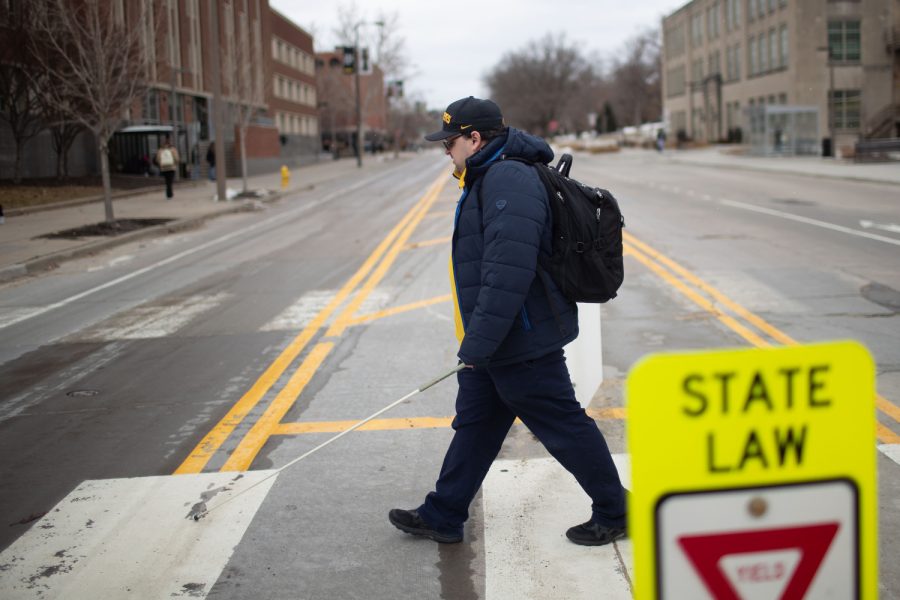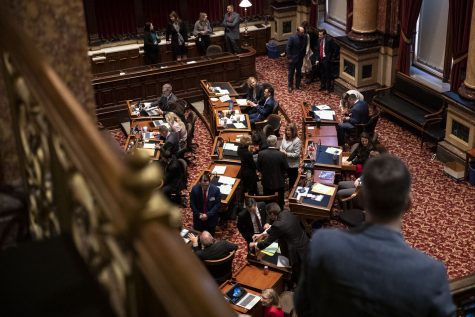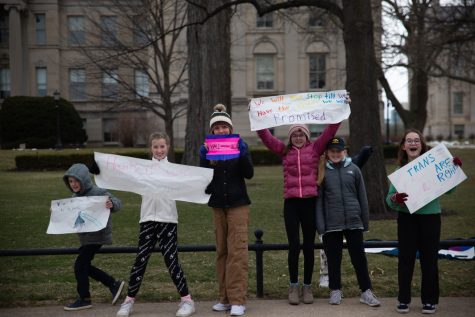From 37 to 16: Bill realigning Iowa state government would reduce number of cabinet agencies
A massive state government realignment bill would make the director of the Iowa Department for the Blind a political appointee of the governor. Advocates worry that it could affect access to care and training for partially sighted and blind Iowans.
Jerad Nylin crosses the street with his white cane by the Main Library on Feb. 23, 2023. Nylin is a blind student attending the University of Iowa. Nylin wears a navy blue coat with a yellow jacket underneath and a black Hawkeye baseball cap.
Jerad Nylin, a third-year nontraditional student who studies criminology at the University of Iowa, first learned how to use a table saw at Iowa’s Blindness Empowerment and Independence center in Des Moines.
Nylin also learned to cook, navigate a busy street, and build a successful career as a person who is partially sighted.
He was born with Leber congenital amaurosis, a genetic disease that affects the retina’s development in early life. Nylin said he has some usable vision, but it’s not reliable. Without Iowa’s Blindness Empowerment and Independence Center in Des Moines, Nylin said he wouldn’t have been able to pursue a degree or his own independence.
Under HSB-126, a 1,600-page bill that would streamline Iowa’s government, some blind and partially slighted Iowans fear they could experience the politicization of the Iowa Department for the Blind administration. Iowa currently has 37 cabinet agencies under its executive branch. The new proposal would reduce that number to 16.
Under the bill proposed by Gov. Kim Reynolds, the director would serve as the governor by political appointment and confirmation by the Iowa Senate. Currently, the Iowa Department for the Blind director is appointed by a three-member council chosen by the governor.
The council typically consists of Iowans who are blind and their advocates, but currently sits mostly empty, with only one member of the council still serving in an official capacity.
The Iowa Department for the Blind’s Blindness Empowerment and Independence Center teaches blind and partially sighted adults braille, navigation, job skills, life skills, and more in its training program.
Many states offer similar training programs for adults. Nylin said the school is the best in the country and the other supports provided by the Iowa Department for the Blind like vocational rehabilitation or helping blind Iowans enter the workforce.
“If you’re going to be blind, it’s best to be blind in Iowa,” Nylin said.
Some Iowans who are visually impaired, like Nylin, worry this change could result in a director who won’t keep the needs of Iowans who are blind or partially sighted in mind. They worry that the director will instead be swayed by political pressures from the Republican governor to cut spending, programs, or more.
“I am just afraid that the services for blind Iowans will be greatly diminished by future budget issues,” Nylin said. “We need a blind director who understands blindness in this state.”
Partially sighted and blind Iowans aren’t the only ones affected by this massive rearranging of Iowa state government. Local governments could also see their power drained by the governor’s proposed legislation.
Gov. Reynolds’ bill would weaken local control in prosecution, corrections
Under the proposed legislation, Iowa local governments will also have less control to make decisions in prosecutorial discretion and community-based corrections.
The bill would enumerate the Iowa Attorney General’s ability to intervene in any legal proceeding regarding an “interest of the state,” granting the attorney general’s office the ability to override local decisions regarding prosecutorial discretion.
It would also give the attorney general’s office direct jurisdiction over election-related crimes.
Calhoun County Attorney Tina Meth-Farrington wrote in an email to state Rep. Adam Zabner, D-Iowa City, that this provision of the bill included post-campaign promises to not prosecute certain crimes to focus resources on other issues.
Polk County Attorney Kimberly Graham, a former Democratic challenger to Republican U.S. Sen. Joni Ernst said during her 2022 campaign that she would not prosecute low-level marijuana possession charges and recommit resources to other crimes during her campaign in 2022.
Meth-Farrington did not mention Graham by name but described her campaign promises in her email read by Zabner during the subcommittee hearing on Feb. 21.
“This language is introducing politics into the mix, and we should not be doing that,” Meth-Farrington wrote.
The section was already established in the Iowa code before the legislation was introduced. The Iowa attorney general’s office said this bill clarifies the overlapping jurisdiction.
Former Attorney General Tom Miller, a Democrat, established an unofficial policy stipulating that the attorney general would only intervene if invited by the county attorney during his 40-year tenure.
Phuong Nguyen, a UI professor of public policy and planning, told The Daily Iowan that removing local control would affect the quality of services Iowans receive from state and local agencies.
According to Iowa Department of Corrections Director Beth Skinner, programs such as community-based corrections would be merged with the Iowa Department of Corrections to consolidate costs and implement more “evidence-based approaches.”
Community-based corrections districts, aligning with all eight Iowa judicial districts, serve as the leaders of state prisons within their jurisdictions and are charged with creating programs to rehabilitate inmates in their district.
Each district’s board has its own building, programs, and parole practices.
Skinner said the separation of these districts and the department led to inconsistency throughout the state. She said this inconsistency caused operational challenges for the department. Merging the functions would standardize corrections and parole throughout the state and allow the department to centralize assets.
Community-based corrections districts would still exist but would be under the Department of Corrections and serve more of an advisory role.
Story County Supervisor Linda Murken, chair of the Second Judicial District’s community-based corrections board, addressed a House subcommittee investigating the bill on Feb. 21. Murken said community-based corrections give a local touch to inmate rehabilitation and allow for innovative, evidence-based practices.
“Evidence-based practices change as you learn new things — that’s the strength of community corrections,” Murken said. “I think we are evolving new evidence-based practices in the community every day and think we’re going to lose the flexibility to do that.”
Republicans tout savings, more functional Iowa government
Reynolds unveiled this proposal during her Condition of the State address in January as a continued effort to realign or streamline state government to ease bureaucracy. Nguyen said the move will also expand the power of the executive branch in the state.
Nguyen said only time will tell if rearranging state government makes a difference in the Iowa government’s administrative burden.
After the Iowa Senate State Government Committee passed Senate Study Bill 1123 on Feb. 22, Reynolds said the bill will accomplish a major conservative policy point — small government.
“State government exists to serve Iowans, but an increasingly growing bureaucracy is making it too complicated,” Reynolds said in a news release. “This bill gets to the heart of the problem, making government efficient, effective, and small.”
HB-126 passed a subcommittee on Monday.
Reynolds also said the bill would save the taxpayers $215 million over four years — less than 1 percent of the general fund budget appropriations.
But Nguyen said local governments are the closest to their constituents, which allows them to be more responsive to local needs than state governments. Taxpayers might see a decrease in the state government’s quality or availability of services.
“The governor or any central state agency cannot decide what each [local] government may need,” Nguyen said. “It must be decided by local residents.”

he/him/his
Liam Halawith is a third-year student at the University of Iowa studying Journalism and Mass Communication and minoring in Public Policy. Before...
















